#micro images
Text






just fucking give michael an oscar already fucking GOD make him STOP
#i know i responded to a meta with these exact images already#but they need their own post because DEAR LORD#the man is a micro-expression connoisseur and i EAT IT TF UP#good omens#michael sheen#he and florence pugh just need to be in something together where they make these faces at each other
3K notes
·
View notes
Text
Wet Beast Wednesday: tardigrades
Last week on Wet Beast Wednesday I covered the largest animals to ever exist on our planet. This week I'm going to pull a full 180 and cover the smallest animals yet on this series. Meet the tardigrade, the internet's favorite micro-animal the is said to be basically immortal. How true is that? Let's see.

(Image: an electron microscope image of a tardigrade. It looks a lot like a potato with eight stubby legs tipped with long claws. At the front is a small, circular mouth. It has no other discernable features. In the background are bits of plant matter that look like seaweed at this scale. End ID)
The tardigrades are 1,300 known species (and probably a lot of unknown ones too) in the phylum Tardigrada. They are also part of the superphylum Ecdysozoa, which are animals that grow by molting their outer cuticles or exoskeletons. In particular, the tardigrades are believed to be a sister group of the arthropods, the group that contains crustaceans, insects, isopods, and a lot of other things. Tardigrades are truly tiny, the largest species reaching a whopping 1.5 millimeters in length, though most species reach no more than 0.5 mm. They have round, segmented bodies with four pairs of legs that end in either claws or suction discs. The body segments consist of a head, three body segments with a pair of legs each, and a caudal segment with the final pair of legs. The first three legs are used for movement while the final pair points backwards and is used for grabbing onto substrate. All of the body segments except for the final one correspond to segments found in the head section of insects. Tardigrades are missing many hox genes, genes that direct the body plan during development. Their ancestors may have had a body plan more similar to insects, but the loss of the hox genes has compressed them into walking heads with a bit of butt. The mouth is tubular and sucks in food. In the mouth are stylets, needle-like structures used to pierce food objects. Once food is drawn into the mouth, a structure called the buccopharyngeal apparatus activates. This is a combination of spines and muscle that acts like an inner jaw that pulls food into the digestive tract. The buccopharyngeal apparatus is distinct enough to be used as a major identifying feature between species. Tardigrades are translucent and many images you've seen of them have false color to show the details or are 3D models based on scanning electron microscope imagery of them. Tardigrades molt their exoskeletons multiple times (up to 12) during their lifecycle. Some species are unable to poop normally and instead all their waste is discarded during the molt. It was formerly believed that tardigrades could exchange genes with each other without mating, a process called horizontal gene transfer that is seen in bacteria, archaea, and other micro-organisms. It has since been discovered that while still capable of horizontal gene transfer, it is quite a bit rarer in tardigrades than we thought.
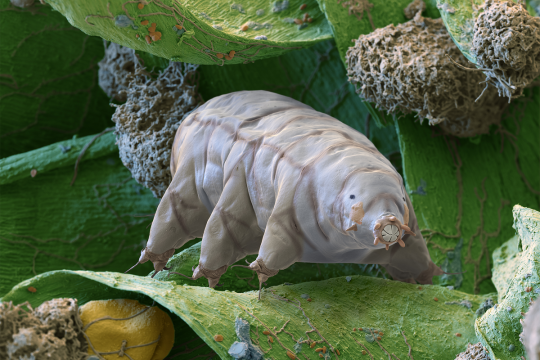
(Image: an electron microscope image of a tardigrade standing on a bit of plant matter. This one has a closed mouth with a ring of triangular tooth-like structures. It also has two simple eyes that look like black dots. End ID)
The name "tardigrade" means "slow walker", which is fitting as, despite their eight legs, tardigrades have a slow and awkward gait. This is the result of their legs being unjointed, only able to pivot at their connection to the body. Their gait has been compared to that of bears, hence why they are often called water bears and their discoverer, Johann August Ephraim Goeze, called them "kleiner wasserbär", meaning "little water bear". Tardigrades are found worldwide and have inhabited virtually every habitat, from the tops of mountains to the deep sea, from hot springs to the antarctic, from freshwater to saltwater. The one thing they have in common is a need to stay wet. Tardigrades can survive out of water as long as they can stay moist and are often found in mosses, hence another common name: moss piglets. The majority either eat plants or bacteria, but some will feed on smaller tardigrades or other micro-animals. Their famous survivability makes it easy for tardigrades or their eggs to be carried to new habitats by larger animals or other phenomena. Tardigrades are one of the first micro-animals to colonize a new habitat and they are a pioneer species, the first species to colonize a new environment and whose presence makes that environment fore suitable for other species to follow. Tardigrades are a major food source to other micro-animals and larger organisms. Most species have distinct males and females, though a few reproduce through parthenogenesis. In most cases, molting female will lay her eggs in her shed cuticle and males will them fertilize them. Other species have a form of internal reproduction. Males and females will court each other before mating and females will usually allow multiple males to fertilize her eggs. Female tardigrades are typically larger and more abundant than males. Eggs can take up to 14 days (species dependent) before hatching. All tardigrades of the same species have the exact same number of cells as each other. They are also born with the same number of cells they will have as an adult. Their growth is driven by enlargement of the existing cells rather than cellular reproduction making new cells. The lifespan ranges between a few months to a few years, depending on species.

(Image: a color photo of a tardigrade. It is a pale, translucent white, making it hard to make out details. Its body is curved, with the front end pointing at the camera. It has two simple eyes. End ID)
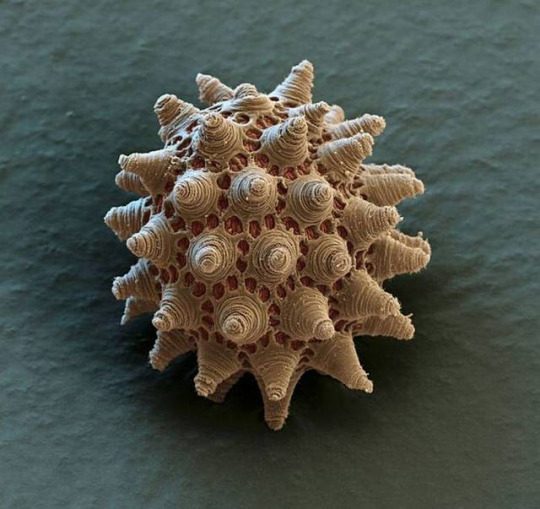
(Image: an electron microscope image of a tardigrade egg. It is round but covered in small pores and conical structures. End ID)
The most famous feature of tardigrades is their legendary durability. It is commonly said that tardigrades can survive just about anything (except for the things that are actually trying to kill them. They are prey to a lot of species after all). Among the things they can survive is extreme heat, extreme cold, dehydration, extremely high and low pressure, exposure to ionizing radiation (that's the scary kind), low oxygen environments, environmental toxins, heavy impacts, and the vacuum of fucking space. While the can survive in extreme conditions, tardigrades are not considered extremophiles. True extremophiles thrive in extreme environments and are negatively impacted by leaving them. Tardigrades can survive in extreme environments, but are negatively impacted and can't survive as well there as they can in less extreme places. The main trait that has allowed tardigrades to survive all five mass extinctions in history is cryptobiosis. Cryptobiosis is the rare ability for an animal to enter a state of dormancy where their metabolic processes come to an almost complete stop. While in cryptobiosis, metabolic activity drops to 0.01% normal and water content drops to 1% normal. In this state, the tardigrade is called a tun. Tardigrades usually enter cryptobiosis in response to arid conditions. One experiment showed that a species of tardigrade could last for at least 30 years in this state and return to normal lifestyle functions when exposed to water. Tardigrades will also enter cryptobiosis in response to low oxygen, toxic chemical exposure, increased or decreased temperature, and excessive salt content in the water. Tardigrades also show extreme resistance to both high and low pressure. They can live in 0 atmospheres of pressure and some species can survive up to 6,000 atmospheres, more than double the pressure at the bottom of the Marianas trench. More interesting is their ability to survive dangerous radiation. They can survive 1,000 times the dose of gamma radiation that humans can. Early tests focused on tardigrades in cryptobiosis and concluded that the extremely low water content of a cryptobiotic tardigrade doesn't leave much opportunity for the radiation to react with the animal. However it was later found that active and fully hydrated tardigrades are still considerably resistant to radiation. Studies into this resistance indicate that tardigrades can very efficiently repair damaged DNA and have unique proteins called Dsup that provides additional protection. Dsup introduced to human cells has provided additional protection against x-rays.
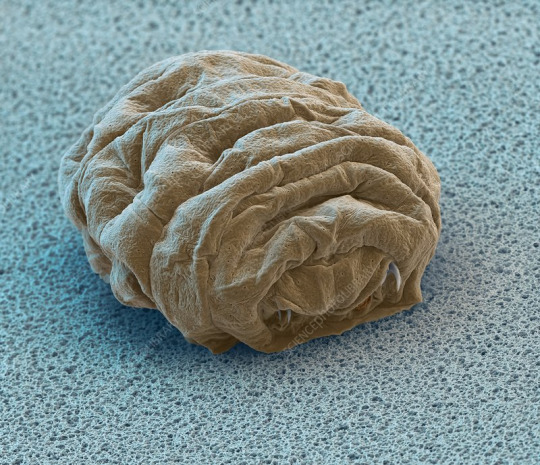
(Image: an electron microscope image of a tun - a tardigrade in cryptobiosis. It is smaller and very wrinkly, with the legs and mouth retracted into the body. End ID)
Tardigrades were the first animals to be exposed to the vacuum of space. They were exposed for 10 days, some in a state of cryptobiosis at the time of exposure and some still active. It was found that they were able to survive the vacuum when shielded from the sun's ultraviolet radiation, with those already in cryptobiosis doing better. Upon being rehydrated, many were able to resume normal life functions and successfully reproduce, though others died after being rehydrated. Those that were exposed to UV radiation fared much worse, with only a few hydrated individuals surviving. The individuals in cryptobiosis had a lower survival rate when exposed to UV than those not exposed to UV and were less successful at reproducing afterwards. Studies of tardigrade's space survival abilities and resistance to radiation could go a long way in helping human space travel. One of the largest dangers of space travel is that space is full of nasty radiation from the sun that Earth's magnetic field protects us from. Some scientists speculate about the possibility of accidentally seeding other planets or moons with tardigrades or other space-resistant organisms. This is a problem because introducing Earth life to other world has the potential to damage any native ecosystems and if we find life in space in the future we don't want to have to figure out if it's something we accidentally put there. While tardigrades could likely survive on other planets, they would eventually die without a food source. Some sources reported that tardigrades may have colonized the moon after an experiment with them crashed. Unfortunately, the moon is not crawling with tardigrades now. It's way too dry for them to exit cryptobiosis even if they survived the crash, which they probably didn't.
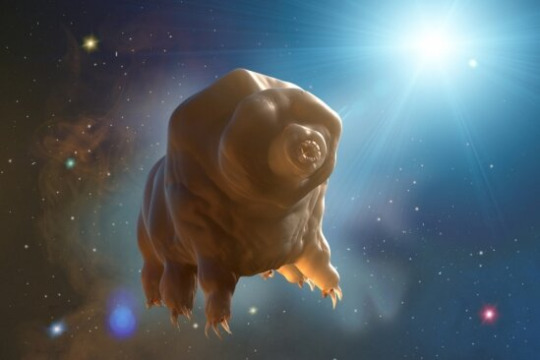
(Image: art of a tardigrade floating in the vacuum of space. End ID. Source: University of California - Santa Barbara)
#wet beast wednesday#tardigrade#water bear#moss piglet#micro animal#microbiology#marine biology#biology#zoology#ecology#animal facts#informative#science#space#astrobiology#radiation#cryptobiosis#tun#image described
155 notes
·
View notes
Photo

Semi-separated nuclei of two cells form a heart-to-heart shape. The nuclei were labeled by lamin.
By Di Lu (China)
Olympus Image Of The Year Award
#di lu#photographer#china#olympus image of the year award#micro photography#semi-separated nuclei#heart-to-heart shape#nuclei#lamin#nature
3K notes
·
View notes
Text






#micro world#magic world#workshop#enchanted forest#fire#snow#creepy forest#cottagecore#dreamscape#miniature#fantasy#ai illustration#ai art#ai art generation#ai artist#ai generated#ai art gallery#ai image#ai artwork#stable diffusion#colorful#cabin in the woods
25 notes
·
View notes
Text
Oh my god so i see these


and then i see this

i’m crying i’m crying and now mikes not here anymore oh my god i’m sorry
#the monkees#mike nesmith#micky dolenz#my babies grew up and now there’s only one of them left!!! noo!!!!#i’m having a crisis again#mike has so much in his eyes. so many little micro expressions in a still image.
36 notes
·
View notes
Text

UK 1987
#UK1987#BRODERBUND#MICRO GRAPHIC IMAGE#ACTION#SIMULATION#C64#ATARI400/800#APPLE#IBM#SPECTRUM#BBC#AMSTRAD#ATARIst#MSX#VIC20#PC 88#FM 7#SHARP X1#MACINTOSH#NES#STEALTH#CHOPLIFTER#SPELUNKER#RAID ON BUNGELING BAY#LODE RUNNER#LODE RUNNER'S RESCUE#CHAMPIONSHIP LODE RUNNER#PC 98
19 notes
·
View notes
Text

Tight N Sexy White Crop Top and Micro Mini Skirt
20 notes
·
View notes
Text
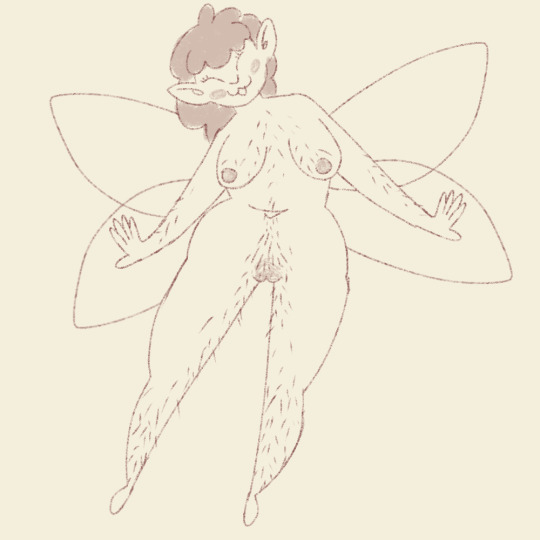
what if there was a little creature
45 notes
·
View notes
Text
thank god for indie devs making like tiny little maximum 10 megabyte freeware games on itchio keeping the art of filesize optimization alive. ASSET REUSE FOREVER!!!!!!!!!!!!!!!!!!!!!!!!!!
#im watching a video about wario land music -> 'the bizarre music and sound design of wario land 4' by geno7#good video so far! i like this guys stuff. he talked a bit about how they did some of the sound effects for warios voice#a very like. chopped and remixed sample style of doing his vocal lines. which is very cool 1) because it saves a bit of#precious space on that gba cartridge BUT ALSO 2) it just sounds cool and interesting stylistically#and man sometimes trying to keep a file size down really does give way for some really interesting stuff#on my own personal interests in games i ADORE rpg makers rtp and how people can find creative uses for it#i love that a bunch of games can draw from the same asset pool as one install on ur computer#no bloating your hardrive with a bunch of copies of the same assets - its just already here!#and from a developers perspective i love when they reuse old assets from other games in new weird ways#some small visual novel companies will reuse backgrounds and other assets#altho i dont mind a bit of bloat with VNs since a big draw can be the big pretty images and big pretty sounds#but its still cool when people find ways to get creative with space saving. and from a players perspective its also nice#space is cheap nowadays. but its not Free. we can swallow terabytes whole with micro sds and everything#but a lot of players dont get the chance or ability to upgrade their internal memory that often. so i think being considerate of filesize i#very important. and thats not even getting into the download bandwidth limits - a lot of people all across north america can only get like#internet from 1 provider and that 1 provider often likes to upcharge and limit shit because they can#we might live in a future where a lot of powerful technology exists. but access to that tech is another story#so remember the filesize. remember the filesize.#dies in your arms
9 notes
·
View notes
Text


some happy little doodols from the other night
#extreme cuddling#soft vore#safe vore#my art#ignore the huge finger print on the second pic#i was kinda blending with my fingers bc it was a lazy night#images arent necessarily connected#since the first one is a lil more half size????#and the second one is DEF micro#i rlly was just shitting around doodling whatever
87 notes
·
View notes
Text
Reasons to love tardigrades!
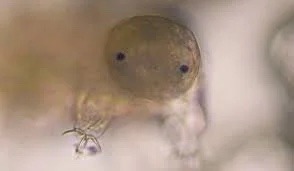
They have little eyes.
#tardigrade#tardigrades#it’s believed they can o ly sense light with them it’s so cute#little man#what does he see?#pretty sure this image is from the journey to the micro cosmos#go watch it it’s on YouTube#microbiology#microorganisms#cute#Tardigrade supremacy
106 notes
·
View notes
Text









#part 2#credit to Alice Oseman for the George image#I did not make it#i need ideas guys leave some#i wish more characters had micro labels#spongebob#spongebob squarepants#yellow sponge#the owl house#lilith clawthorne#Owl House#steven universe#peridot#loveless#georgia warr#straight up netflix#straight up#straight up 2019#todd straight up#asexual#aromantic#asexual spectrum#aroace#big mouth#elijah big mouth#sex education#sarah Owens#shadowhunters#Raphael Santiago#dc legends of tomorrow
17 notes
·
View notes
Text

These cabbage-like nickel phosphate particles have been synthesised by a solvothermal process. Not suitable for Chiko Roll filler.
Photograph: Valentino Kaneti/AIBN
2023 Australian Institute For Bioengineering And Nanotechnology Image Contest
#valentino kaneti#photographer#australian institute for bioengineering and nanotechnology image contest#micro photography#cabbage-like nickel phosphate particles#solvothermal process#nature
10 notes
·
View notes
Text
OKAY I was going to post all of my Teal Mask live blogging in one post BUT I just got to a certain point in the story and I feel it's too important for me to NOT post it on its own.
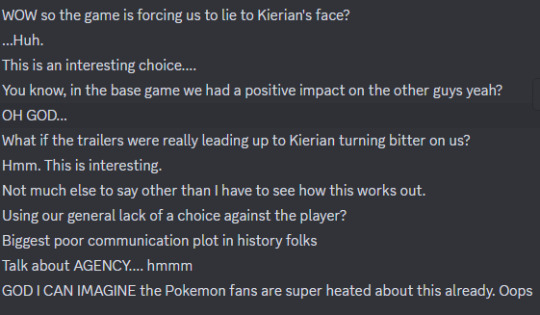
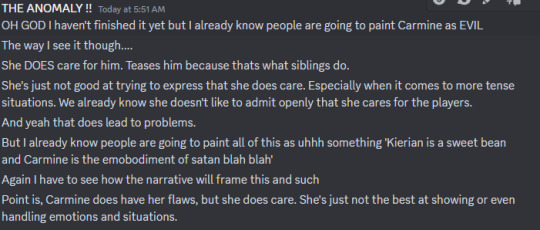
Adding onto the second one... I think yeah... Carmine tends to do stuff without thinking of how others would feel about it. Again, I'm going to wait to see how these decisions play out and if this aspect of her will be explored... And how the story treats it. Again I haven't finished yet so this is subject to change.
But still... Keep that in mind.
#iozoneposts#.txt#teal mask spoilers#pokemon dlc spoilers#spoilers#also i want to study carmine like a micro-organism#is that how you guys say it#alt text in image
7 notes
·
View notes
Text

THE FIRST SCREENSHOT...........I'm not ready 🥲🥲🥲🥲
#but I'm excited to the dectective trio!!!#I do hope ranpo has his bear suit#because it doesn't look like he does in the screenshot#micro analysing every image#bsd s4 spoilers
27 notes
·
View notes
Text










Liu Chang 【刘畅木法沙】
#liu chang#just because i'm still obsessed with this hair#i wish i could gif right now but i haven't the mental fortitude#one day i will find someone who can actually do real image editing to commission liu chang gifs as a treat#his face is just SO GOOD#it's harder to capture in stills bc of how fast the microexpressions shift#one of things i'm most grateful for in untamed fandom is all the beautiful hd gifs of every tiny acting choice#if i could get the hang of image software i'd be giffing all the old videos but i'd also#become lost and sucked into the image-editing void and miss all my commitments lol#idk how vidders and gifmakers manage their time bc i fall to micro-tweaking and lose entire days for even paltry screenshots#gods know there are enough artists of the screenshot around here to show that what it probably takes is talent and an eye#which uh i do not have#but i still *really* like his face ok?
38 notes
·
View notes